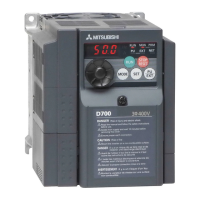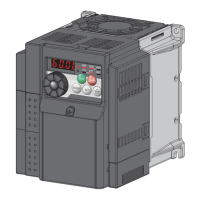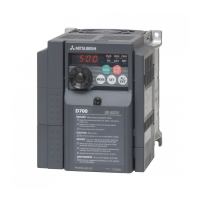What to do if Mitsubishi Electric Inverter shows PU disconnection?
- KKimberly HeathSep 6, 2025
This function stops the inverter output if communication between the inverter and PU is suspended. Connect the parameter unit cable securely.

What to do if Mitsubishi Electric Inverter shows PU disconnection?
This function stops the inverter output if communication between the inverter and PU is suspended. Connect the parameter unit cable securely.
What to do if Mitsubishi Electric Inverter has overcurrent trip during acceleration?
If the inverter output current reaches or exceeds approximately 200% of the rated current during acceleration, the protective circuit activates and shuts off the inverter output. You can increase the acceleration time. If "E.OC1" is always lit at starting, disconnect the motor and start the inverter. Check for output short-circuit/ground fault and set 50Hz in Pr. 3 Base frequency.
What causes Mitsubishi Electric FR-D720-0.2K overload trip and how to fix it?
The inverter output stops if the temperature of the output transistor element exceeds the protection level when a current not less than the inverter rated current flows and overcurrent trip does not occur (200% or less). To resolve this, increase the acceleration/deceleration time.
What does it mean when my Mitsubishi Electric FR-D720-0.2K Inverter shows an inverter overload trip?
An inverter overload trip on your Mitsubishi Electric Inverter means the electronic thermal relay function, which protects the inverter elements, has been activated. To resolve this, try increasing the acceleration/deceleration time, adjusting Pr. 0 Torque boost setting, setting Pr. 14 Load pattern selection appropriately, reducing the load, or ensuring the surrounding air temperature is within the specified limits.
What does output current detection value exceeded mean on Mitsubishi Electric Inverter?
This function is activated when the output current exceeds the Pr. 150 Output current detection level setting. Check the settings of Pr. 150 Output current detection level.
What causes a stall prevention (overcurrent) on a Mitsubishi Electric FR-D720-0.2K and how to fix it?
The overcurrent stall prevention on your Mitsubishi Electric Inverter has been activated. To resolve this: * Increase or decrease the Pr. 0 Torque boost setting by 1% and check the motor status. * Set a larger value in Pr. 7 Acceleration time and Pr. 8 Deceleration time. * Reduce the load weight. * Try General-purpose magnetic flux vector control. * Adjust the Pr. 13 Starting frequency setting. * Change the Pr. 14 Load pattern selection setting. * Set the stall prevention operation current in Pr. 22 Stall prevention operation level.
How to resolve analog input fault on Mitsubishi Electric Inverter?
An analog input fault appears if voltage(current) is input to terminal 4 when the setting in Pr.267 Terminal 4 input selection and the setting of voltage/current input switch are different. Give a frequency command by current input or set Pr. 267 Terminal 4 input selection, and voltage/current input switch to voltage input.
What happens when Mitsubishi Electric FR-D720-0.2K has output phase loss?
If one of the three phases (U, V, W) on the inverter's output side (load side) is lost during inverter operation, the inverter stops the output. Ensure that the cables are wired properly.
What to do if my Mitsubishi Electric Inverter is showing overcurrent trip during constant speed?
If your Mitsubishi Electric Inverter is showing an overcurrent trip during constant speed operation, make sure the load is stable. Also, check the wiring for any output short circuits or ground faults. Try lowering the stall prevention operation level and activating both the stall prevention operation and the fast-response current limit operation (Pr.156).
What causes regenerative overvoltage trip during constant speed on Mitsubishi Electric FR-D720-0.2K?
If regenerative energy causes the inverter's internal main circuit DC voltage to reach or exceed the specified value, the protective circuit is activated to stop the inverter output. Ensure that you keep load stable.
| Model | FR-D720-0.2K |
|---|---|
| Series | FR-D700 |
| Type | Inverter |
| Input Voltage | 200-240V AC |
| Output Power | 0.2 kW |
| Output Current | 1.0 A |
| Output Frequency | 0-400 Hz |
| Amperage | 1.0 A |
| Frame Size | A |
| Input Frequency | 50/60 Hz |
| Cooling Method | Fan cooled |
| Output Voltage | 200-240 VAC |
| Control Method | V/f Control |
| Protection | Overcurrent, Overvoltage, Undervoltage |
| Protection Features | Overvoltage, Undervoltage |
Describes the terminal connection diagrams for main and control circuits, including signal and power wiring.
Details the main circuit terminals, including power input, motor output, and connections for brake resistors and reactors.
Explains the functions and specifications of control circuit terminals for input signals, output signals, communication, and safety stop.
Discusses measures to reduce electromagnetic noise and leakage currents to prevent malfunctions and ensure proper operation.
Highlights crucial safety precautions and handling instructions to prevent product damage or shortened lifespan due to incorrect usage.
Describes methods for implementing failsafe systems using inverter status output signals to prevent accidents if the inverter fails.
Provides a comprehensive list of all inverter parameters, their settings, and corresponding pages for detailed explanation.
Details how to adjust motor torque boost, slip compensation, and stall prevention for optimal performance.
Describes automatic restart and power failure deceleration functions to maintain operation or ensure safe shutdown during power interruptions.
Details the retry function and input/output phase loss detection to automatically recover from or prevent faults.
Covers functions like reset selection, disconnected PU detection, parameter write disable, and password protection to prevent misoperation.
Details the procedures for resetting protective functions after a fault occurs to resume operation.
Provides a reference list of all possible fault and alarm codes displayed on the operation panel, with corresponding descriptions and page numbers.
Offers detailed explanations of common fault and alarm causes and their corresponding corrective actions.
Provides a systematic checklist for common troubleshooting scenarios, starting with basic checks before escalating.












